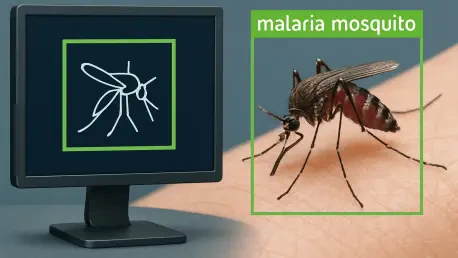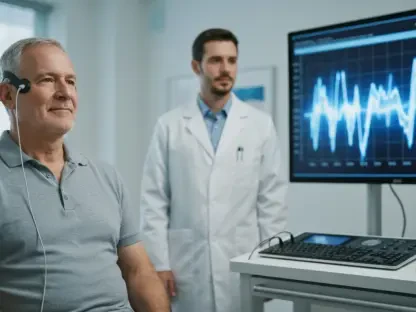Imagine a world where a simple smartphone photo taken by an everyday person could be the key to preventing a deadly malaria outbreak, saving millions of lives in the process, and this scenario is no longer a distant dream but a tangible reality thanks to groundbreaking research from the University of South Florida (USF). Led by scientists Ryan Carney and Sriram Chellappan, this innovative study merges artificial intelligence (AI) with citizen science to revolutionize the surveillance of vector-borne diseases like malaria. Published in the journal Insects, the research unveils the potential first sighting of Anopheles stephensi, a dangerous malaria-carrying mosquito, in Madagascar. This invasive species threatens urban areas across Africa, putting an estimated 126 million additional people at risk. By harnessing mobile technology and public participation, this approach addresses critical gaps in traditional disease monitoring, offering hope for a more proactive defense against one of the world’s deadliest pathogens.
Harnessing Technology for Early Detection
The core of this transformative research lies in the seamless integration of AI-powered image recognition with contributions from ordinary citizens. A striking example comes from Antananarivo, Madagascar, where a resident submitted a smartphone photo of a mosquito larva in a tire via NASA’s GLOBE Observer app. AI algorithms, trained on thousands of authenticated mosquito images, analyzed the photo with over 99% confidence, identifying it as Anopheles stephensi. While genetic testing for official confirmation couldn’t be conducted due to the destruction of the specimens, the discovery of over 100 similar larvae in the vicinity heightened concerns. This finding is particularly alarming given the doubling of malaria cases and deaths in Madagascar during the same period. The ability to detect such threats through accessible technology underscores a pivotal shift in how public health challenges are addressed, emphasizing speed and community involvement over traditional, often slow, surveillance methods.
This technological breakthrough extends beyond a single discovery, highlighting the potential for scalable early-warning systems. The study reveals that only 3% of mosquito species transmit diseases to humans, yet identifying these dangerous few among countless harmless ones is a daunting task. AI offers a solution by processing vast amounts of data from public submissions, acting as a digital filter to pinpoint threats like Anopheles stephensi. The significance of this cannot be overstated, as mosquitoes—often called “tiny flying hypodermic needles”—infect over 700 million people annually with various pathogens, causing nearly half a million deaths among children under five due to malaria alone. By leveraging smartphones as tools for data collection, the research empowers communities to play an active role in safeguarding their health, bridging the gap between scientific expertise and grassroots action in a way that was previously unimaginable.
Global Implications and Local Challenges
The implications of this research resonate far beyond Madagascar, touching on urgent public health concerns worldwide, including in the United States. Local malaria outbreaks were reported in the U.S. in recent years, marking the first such incidents in two decades, with Florida bearing the brunt of the cases. This resurgence positions the state as a critical hotspot for mosquito-borne diseases, necessitating heightened vigilance. The USF study underscores the importance of proactive surveillance not just in distant regions but also closer to home, where changing environmental conditions and global travel increase the risk of invasive species taking hold. The potential spread of vectors like Anopheles stephensi in urban settings—where they thrive in artificial containers like buckets and tires—poses a unique challenge that traditional methods often fail to address, making innovative approaches all the more vital.
Further amplifying the urgency is the global scale of the malaria crisis, which continues to devastate vulnerable populations. The research emphasizes that early detection through AI and citizen science can transform how regions prepare for and respond to outbreaks. In Africa, where the burden of malaria is heaviest, the introduction of invasive species could exacerbate an already dire situation, threatening millions more lives. Meanwhile, in the U.S., the lessons learned from this study could inform strategies to prevent local transmissions from becoming widespread epidemics. The multidisciplinary collaboration at USF—spanning integrative biology, AI, cybersecurity, and public health—demonstrates how diverse expertise can converge to tackle complex issues. Supported by grants from the National Institutes of Health and the National Science Foundation, this initiative sets a precedent for how technology and community engagement can work hand in hand to protect public health on a global stage.
Pioneering the Future of Public Health Surveillance
Looking ahead, the research team at USF is poised to push boundaries even further by developing AI-enabled smart traps for remote identification of dangerous mosquitoes. These next-generation tools, likened to facial recognition for mosquitoes, aim to enhance surveillance in high-risk areas like Florida and beyond. Built on algorithms trained with thousands of images of both larvae and adult mosquitoes, this technology addresses the limitations of conventional methods that often miss invasive species until it’s too late. The vision is to create a network of smart systems that can autonomously detect and alert authorities to potential threats, reducing reliance on labor-intensive fieldwork. Such advancements promise to redefine public health surveillance, making it more efficient and responsive in an era where rapid action can mean the difference between containment and catastrophe.
Reflecting on the strides made, the study also highlighted the power of citizen science as a cornerstone of this new paradigm. By turning smartphones into tools for data collection, the research democratizes science, allowing anyone with a device to contribute to global health efforts. This approach not only amplifies the reach of surveillance but also fosters a sense of shared responsibility among communities. The potential first detection of Anopheles stephensi in Madagascar served as a wake-up call, illustrating how a single image can spark widespread action. As these technologies evolve, the focus remains on scalability—ensuring that solutions developed in one region can be adapted to others facing similar threats. The commitment to continued investment in AI and public participation offers a blueprint for combating vector-borne diseases, paving the way for a future where technology and humanity collaborate to outsmart nature’s deadliest carriers.
Building Momentum for Global Health Solutions
In retrospect, the USF-led study marked a turning point in the battle against malaria and other vector-borne diseases through its innovative fusion of AI and citizen science. The efforts to identify threats like Anopheles stephensi in Madagascar underscored the urgency of closing surveillance gaps with accessible tools. Moving forward, the focus should shift to expanding these technologies, ensuring they reach the most vulnerable populations where the impact of malaria is felt most acutely. Governments and organizations must prioritize funding for smart traps and mobile apps that empower communities to act as the first line of defense. Collaboration across borders will be essential to adapt these solutions to diverse environments, from urban centers in Africa to rural areas in the U.S. By building on the foundation laid by this research, the global health community can forge a resilient framework that anticipates and mitigates the spread of deadly pathogens before they claim more lives.









